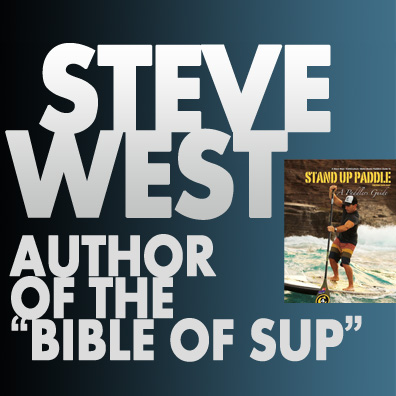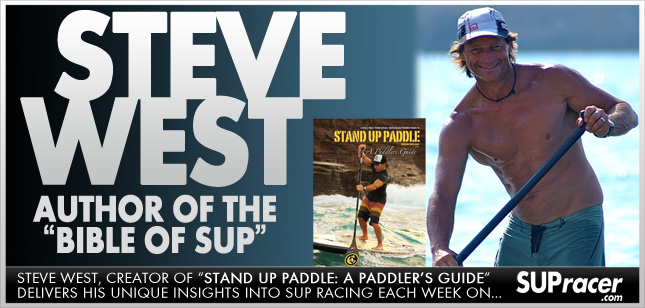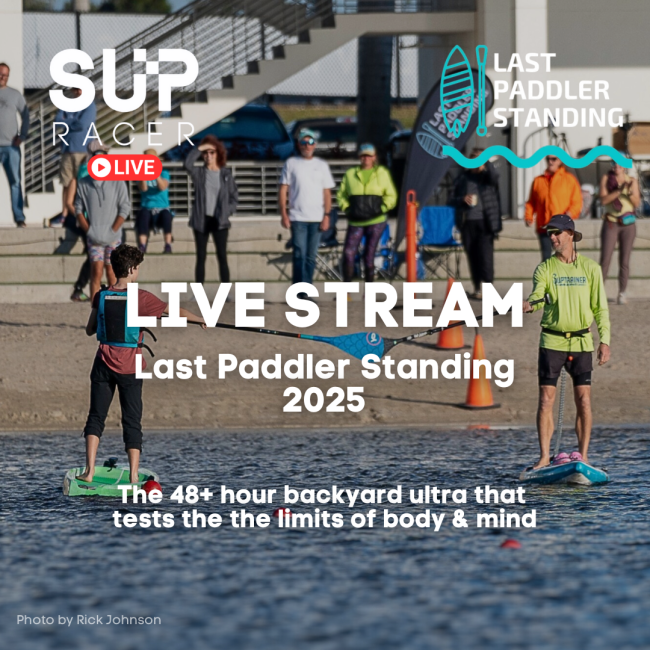
“Where Did We Come From And Where Are We Going?” Steve West Continues The SUP Race Board Restrictions Debate

Boss Man’s note: Yep, the board class and board restrictions debate rages on. It’s not going to stop either, because this is a mildly important topic that could have mildly huge implications for the future of the sport, depending on which way the dust eventually settles.
One of the chief protagonists so far has been our guest columnist Steve West, a highly respected author from the world of paddling who is also highly opinionated, especially on the topic of board restrictions (oh and he also has a kickass SUP book available to buy).
We threw Steve to the lions in April and May when he talked about board restrictions killing the sport, and now he’s back to do battle once more. So check out his latest pot-stirring thoughts below and then leave a comment at the bottom.
MORE ON THE DEBATE >>>
>>> Jim Terrell’s “4 Metre Stock Class” Proposal (and his response to the critics)
>>> Steve West’s “The Irrationality of SUP Race Board Restrictions” (and his follow-up post to answer the critics, and his second follow-up to answer the other critics)
>>> Why Are Men and Women Racing Different Boards?
Where Did We Come From And Where Are We Going?
Excuse my silence of late. We’ve had a change of venue to Fiji – an old stomping ground of mine, a place from which you can relax somewhat and view things from a differing perspective.
The recent on going concern regarding race board specifications has been an interesting journey in hearing the many varied views from around the globe. Continued ease of participation for all comers at race level in relation to board design extremes, particularly in the context of flat, sheltered waters, where the appeal is high and where expansion is inevitable is the central theme.
2013 is the first year of the sports evolution where the European race scene could be said to have truly arrived and where significant ‘others’ from the USA and Australia in particular, have made the journey to embrace and support its arrival, mirrored by an emerging, inevitable gene pool of European talent.
Though contemporary evolution and expansion of the sport began in Hawaii and spread to the USA, any discussions over rulings, the future or the way forward, need embrace a global mindset, as against that of any one singular nationalistic one.
A ‘Class’ of Person versus a ‘Class’ of Board
Racing isn’t fair, it’s not meant to be, much like life when we begin to make comparisons or attempt to find sense in it all, we realise that much of what we experience is out of our hands. Here we want to bring fairness in relation to the boards we use, at least this seems to be the thrust.
We don’t ‘Class’ paddlers by height, weight, strength, fitness, ability, socio-economic status, experience or any other such anomaly, all accept age on occasion. So we try to find sense in all of this by creating a board for all-comers. Ultimately it could be said, it won’t make much difference with regards to who continues to win, but rather who can line up next to them.
Having to choose between a 12’6 or 14′ board is creating angst and anxiety and something has to give. Will a 13’1 board resolve this? And what’s wrong with simply having one size of board up to 14′ and then an unlimited size over this? And should we ask what is wrong, if anything, in ending the evolution of the race board by defining a very specific length and set of specs?
The ‘Stock’ Board Farce
‘Stock’ is meant to mean ‘Stock Standard’ but it’s a misleading term, simply because the boards used by top pro-riders are generally significantly narrower and lighter than the ‘off the shelf’ item and herein lies a vital self governing process which manufacturers are loop-holing.
If it were a requirement that race boards must replicate ‘exactly’ what can be bought in the shops by all-comers, manufacturers would be forced to produce boards that were rideable by a sufficient enough number, to be economically viable to do so. This is not the current way of things. Pro-riders should ride exactly what is in the brochure and on the shop floor in every way and this should apply to proto-types. This keeps the system honest and certainly ensures that when you walk in the shop, you know you’re investing in the identical board your favourite pro-rides and not a watered-down hybrid.
But then I got to thinking . . . this too is flawed for the simple fact this does not prevent bespoke custom board shapers rustling something up in the chicken shed, much like C1 canoes got out of hand to some degree.
So how can this be controlled? Specification rulings.
Hanging onto Surfing Roots
If it’s being suggested we cling to the sports surfing roots and continue to design surfboard styled designs for flat water, there is a worry this could well be a losing battle. While there is some consensus SUP boards should not manifest into becoming stand up Canoe-Boards nor even stand up Kayak-Boards and by design too difficult to manage for most, you cannot but help think that this is where flat water designers want to go and at least a reasonable number of paddlers.
While rulings could serve to prevent this, breakaway groups could well manifest regardless of how we act if we don’t get it right.
Nurturing An Evolutionary Inevitability
Given you can legally turn up to a flat-water event with a kayak or canoe, paddle it standing on account of no ruling to prevent you doing so, speaks volumes about a gestation period without definitions or caveats.
Perhaps this was needed to see where both the industry and the riders would take it, but now that there is a threat that we’re moving away from the realms of the surfboard to that of the canoe and kayak, the alarm bells are sounding.
Defining Paddling while Standing
I make it pretty clear in my book, that while we have been fussing over board spec rulings, we have failed in part to take time out to define ‘what is’, or ‘is not’ a stand up paddle board in addition to issues of its propulsion, which should at the very least have been the first defining quality we should have agreed upon before we started fretting over board lengths. We didn’t and here we are.
What is in part being discussed now, is what defines a board in being ‘In the spirit of the sport’ or in more simple terms, what defines a board over that of a canoe (or kayak) or even a hybrid of both. Perhaps if a stand up board no longer approximates the look of a (surf) board and is more like that of a flat water racing canoe requiring a radical modification of the bio-mechanical attributes we ‘agree upon’ which define the act of stand up paddle boarding in difference to stand up canoeing, it could be argued the sport has deviated from its contemporary origins.
Ultimately, there should be definitions which limit certain bio-mechanical actions (techniques / styles) employed during execution of the forward stroke – relating to stance in particular.
“Where a rider is positioned such that they cannot and do not switch paddling sides and are reliant upon steering strokes and power strokes employed on one side only, combined with a plunge-stroke, exaggerated high-knee, split-stance and radical lowering of the centre of gravity or any combination of these factors, this shall be deemed not to be in keeping with the spirit of the sport.”
“Riders may not use foot chocks or blocks for added control or drive . . .”
With the possibility of a paddler adopting a radical move away from what we agree to be, ‘standing while paddling’ using a squat, high-knee, split-stance posture, where switching sides is ultimately neither required or desirable, the rule book should state this as not-permissible to discourage a move toward C1 sprint canoe styled techniques and by default creation of board designs which demand it.
The European Factor
One of the sports newcomers, Mistral, with a history stretching back to 1976, have produced three differing Olympic Windsurfing one design boards and their latest SUP offering reads . . . “We have fused the positive characteristics of a kayak with those of a surfboard. The Mistral M2 Kayak-SUP Flatwater Racers are trimmed for 100% speed. It’s conically tailored and measures 66cm at the top only 60cm at the bottom . . .”
Mistral, Fanatic, BIC and Starboard to name but a few, have their roots and origins firmly set in Europe, where there are some 500 million people, 27 countries and 23 languages and an abundance of canoe and kayak paddlers that far outweigh that of surfers. These are not trivial companies, but powerful, influential forces to be reckoned with. Forged from the hay-day of Windsurfing, they will conform to rulings, but are very much at home in pushing the envelope on design and innovation, a factor that ultimately helped niche the sport into a corner. Without clear boundaries they are free to evolve race boards as they and their riders see fit.
Like Windsurfing, the USA may have kick started it, but from the moment the Europeans took a hold of it (and had to fight it in the courts to do so) things radically changed, not least of which because of the huge diversity of culture, geography and demographics. There was not one race of people applying their will upon the sport, but a vast number in a concentrated area.
No Guarantees
Who will enforce and police new rulings and if you think they will be sufficient to ensure boards are rideable by all-comers, think again, as this does not prevent designers looking for other ways to make a board quicker with lowered drag co-efficient factors – semi displaced (rounded) cross-sectional hull designs, will evolve without question as used in C1 or rowing scull designs, though introducing a 7cm max recess depth would help limit this by degrees.
Cautionary Notes Regarding Provenance
Historically speaking there are some anomalies we need be mindful of, none of which may ultimately have any baring on how stable or unstable a craft we wish to create. Paddling while standing does not have it’s roots entirely within that of the surf culture (unless you want to look back only as far as Hawaii). This is not an opinion, it’s a fact, but the idea that the sport does have such roots sells boards and serves it well.
” . . . the commercial use of surfing has inspired far more at the level of collective activity than just mass shopping . . . images that tap into mass fantasies inspire collective behaviour – both consumer and sub or counter-cultural behavior. Insofar as they are responses to popular images of freedom like that of the surfer, both kinds of behaviour are constituted at heart by the attempt to make the fantasy real. It is this collective attempt on the part of the mass public that characterizes the social and historical impact like that of the surfer, through images that inspire.” The American Surfer – Radical Culture and Capitalism – Kristin Lawler.
Without labouring the significance of outrigger canoeing to that of the Waikiki Beach Boys and their part in the sport, you have to go back to Africa and see fisherman standing and paddling their canoes as they have done so for thousands of years, to know what ‘roots’ you’re talking about.
I grew up in West and East Africa, Mauritius, Java and spent 25 years travelling the Pacific. Seeing people paddling while standing has been with me all my life. This grass roots view respects the true source of what we Euro-centrically seem to want to attribute to the commercial might of the surfing industry.
Knowing this will ensure you are ready for the backlash from those who want to take this as a point of provenance as against an alternate source such as that associated with surfing. This singular lineage will support those who believe that standing within what amounts to a dug-out canoe by some quantifiable measure, is justifiable on the grounds of provenance. I really don’t care what you decide . . . I’m just pointing it out and be assured they may well reference this fact as being significant.
In the context of flat water racing, I’m not so sure that those from a canoeing and kayaking background will necessarily find appeal for SUP simply because of romantic notions of the surfing culture – they may simply find appeal in a different way to swing a paddle and their numbers are significant and growing.
Racing is a niche interest and certainly the ‘sport’ component of the greater sum of the whole of what is for many simply a ‘recreation’. It is the cauldron and chalice from which the greatest improvements in equipment manifest. Those who race, are generally prepared to spend more on board and paddle in the pursuit of improved performance – those who do not, generally want a means to end within a budget. A minimum weight ruling will help offset an elite price point or at least an exorbitant one in a climate where board prices are already bordering on the ridiculous.
Extreme flat-water race boards may kill off the niche interest of racing, but not ‘the sport’ per se. The un-checked evolution of extreme race boards however, would very probably kill off a particular part of a manufacturer’s product line, as participant numbers went into to decline. This would be a great shame, a shame on us for not making the effort to dictate to the board makers and race directors what needs to happen…
– Steve
*****
What do you think? Do you agree? Disagree? No matter what your opinion is, we’d love you to share it…
LEAVE YOUR COMMENT BELOW…




You must be logged in to post a comment.